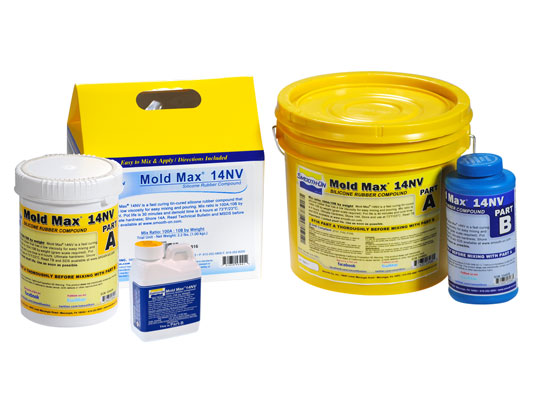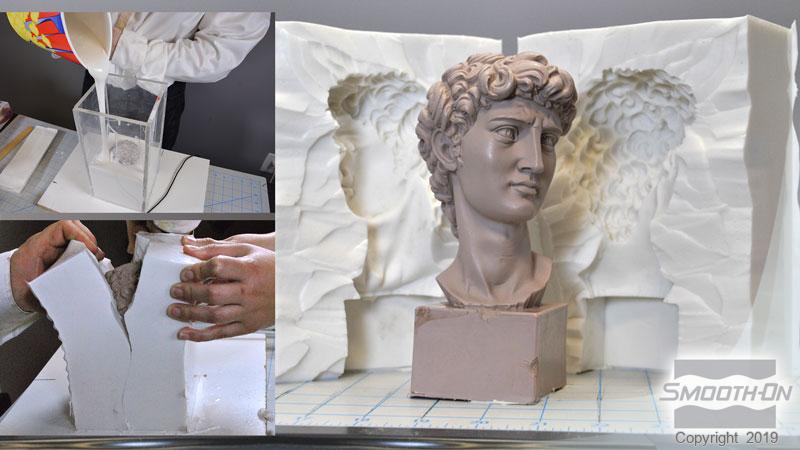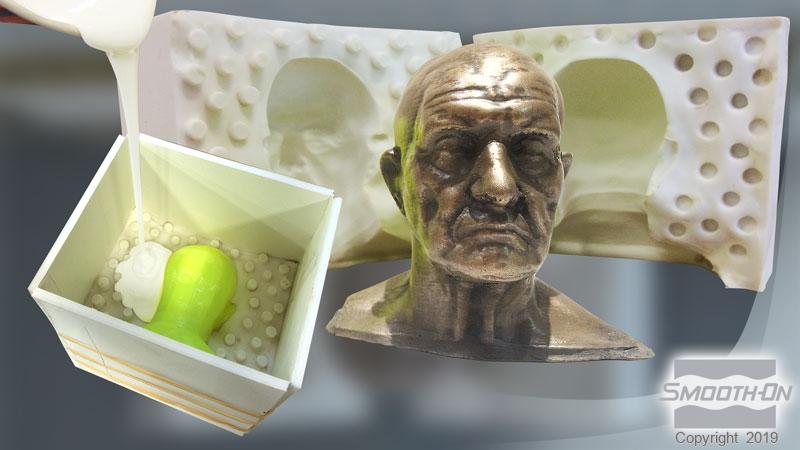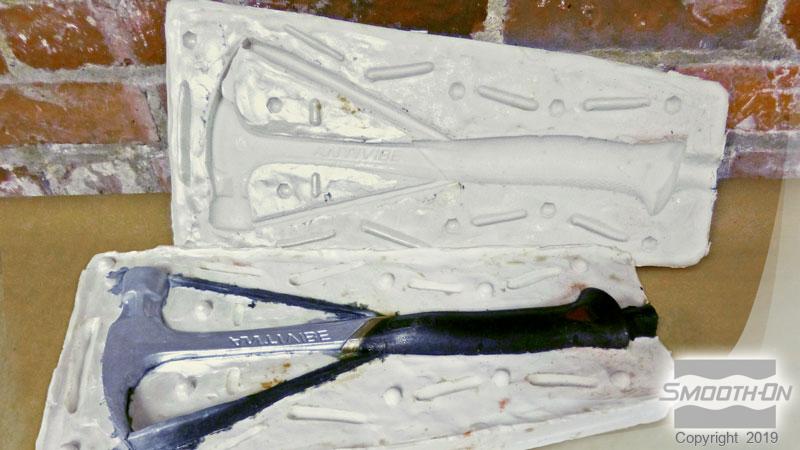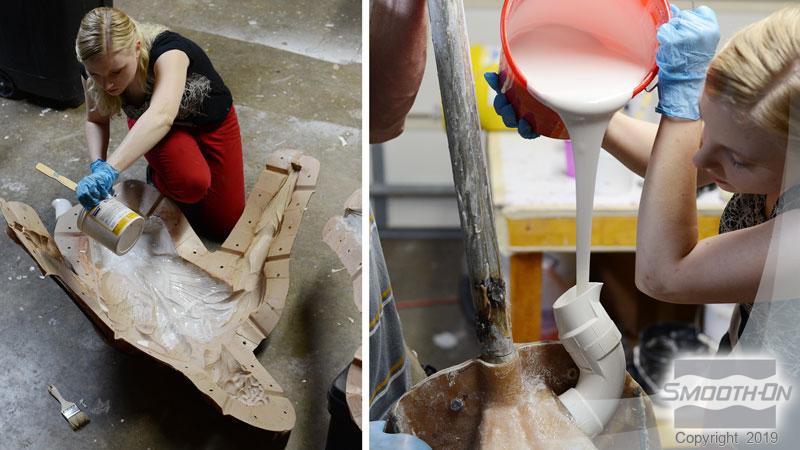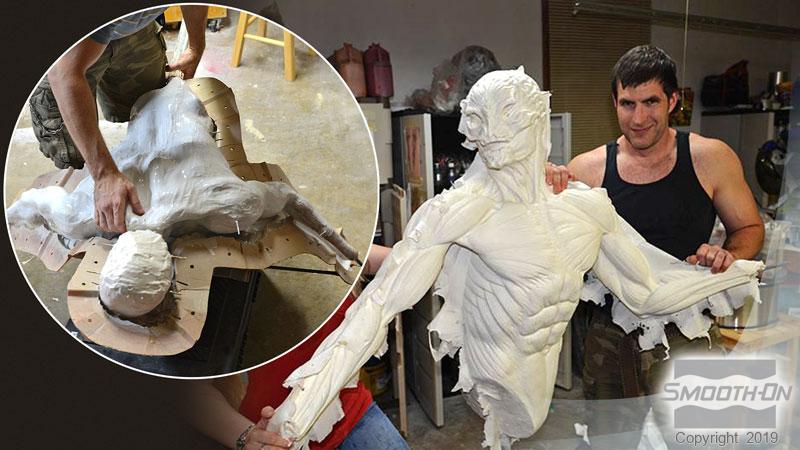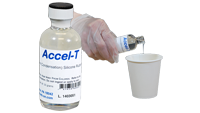Mold Max™ 14NV
Mold Max™ 14NV is a Shore 14A tin-catalyzed silicone rubber that offers low viscosity, fast cure and long library life. Mold Max™ 14 NV does not require vacuum degassing. Mix ratio is 100A:10B by weight. Working time is 40 minutes and cure time is 4 hours at room temperature. Mold Max™ 14NV will reproduce the finest detail and is suitable for a variety of industrial and art related applications including making molds for reproducing prototypes, furniture, sculpture and architectural elements.
Mold Max™ 14NV can also be used to create movie special effects. Cure time can be reduced with Accel-T™ cure accelerator. Mold Max™ 14NV can be used to cast a variety of materials including wax, gypsum, low melt alloys/metals and urethane, epoxy or polyester resins. Important; Do not cast concrete into rubber molds made with this product. Concrete will not cure properly and inhibition will result.
Important; you must weigh Part A & B components using a gram scale to be successful with Mold Max™ 14NV.
Features
- Mold Max™ 14NV has a fast cure time - 4 hours at room temperature
- Mold Max™ 14NV does not require vacuum degassing
- Low viscosity for easy mixing and pouring
› Click here for more Mold Max™ silicone products.
Instructions
Important: you must weigh Part A & B components using a gram scale to be successful with Mold Max™ 14NV.
Because no two applications are quite the same, a small test application to determine suitability for your project is recommended if performance of this material is in question.
Applying a Sealer / Release Agent - Mold Max™ 14NV rubber may be inhibited by sulfur base clays resulting in tackiness at the pattern interface or a total lack of cure throughout the mold. If compatibility between the rubber and the surface is a concern, a small-scale test is recommended. Apply a small amount of rubber onto a non-critical area of the pattern. Inhibition has occurred if the rubber is uncured after the recommended cure time has passed. To prevent inhibition, a “barrier coat” of clear acrylic lacquer sprayed directly onto the pattern is usually effective. Allow to thoroughly dry. Although not usually necessary, a release agent will make demolding easier when casting into or over most surfaces. Ease Release™ 200 is a proven release agent for making molds with silicone rubber and for releasing new silicone from cured silicone. Mann Ease Release™ products are available from Smooth-On or your Smooth-On distributor.
Measuring & Mixing - Materials should be stored at about 73°F / 23°C. These products have a limited shelf life and should be used as soon as possible. Wear safety glasses, long sleeves and rubber gloves to minimize contamination risk. Before you begin, pre-mix Part A (base) thoroughly to re-disperse fillers that may have settled. Using a gram scale, dispense required amounts of parts A and B into a mixing container and mix for 3 minutes. Scrape the sides and bottom of the container several times.
Pouring / Curing / Post Curing- - For best results, pour your mixture in a single spot at the lowest point of the containment field. Let the rubber seek its level up and over the model. A uniform flow will help minimize entrapped air. The liquid rubber should level off at least 1/2” (1.3 cm) over the highest point of the model surface. Allow the mold to cure 4 hours at room temperature (73°F / 23°C) before demolding. Post curing the mold an additional 4 hours at 150°F / 65°C will eliminate any residual moisture and alcohol that is a by-product of the condensation reaction that can inhibit the cure of some urethane resins and rubbers. Allow mold to cool to room temperature before using. Do not cure rubber where temperature is less than 65°F /18°C.
Accelerating Mold Max™ 14NV - Accel-T™ tin cure silicone rubber accelerator will accelerate the cure time of Mold Max™ 14NV. Note: working time is reduced in proportion to the amount of Accel-T™ added. See the Accel-T™ technical bulletin (available from Smooth-On or your Smooth-On distributor) for exact mix ratios and cure times. Using this accelerator will result in a shorter library life of the mold.
| % Accel-T™ (Added by Weight to Part B) |
Pot Life | Cure Time | |
| Mold Max™ 14NV | 0.2 1 |
25 minutes 4.5 minutes |
2 hours 15 minutes |
Silicone Thinner™ is a non-reactive silicone fluid that will lower the mixed viscosity of tin cure (condensation) or platinum cure (addition) silicone rubbers. Silicone Thinner™ offers the following advantages: [1] Mixed rubber (A+B) will flow better over intricate model detail; [2] Silicone Thinner™ will lower the ultimate shore hardness (durometer) of cured silicone rubber; [3] Pot life (working time) is increased in proportion to the amount of Silicone Thinner™ used. A disadvantage is that ultimate tear and tensile are reduced in proportion to the amount of Silicone Thinner™ added, however knotty tear properties of the Mold Max™ Series rubbers are unaffected. It is not recommended to exceed 10% by weight of total system (A+B). See the Silicone Thinner™ technical bulletin (available from Smooth-On or your Smooth-On distributor) for full details.
Due to low viscosity, Mold Max™ 14NV is not recommended for making brush-on rubber molds. If you want to make a brush-on rubber mold, Mold Max™ Stroke™ was developed especially for this purpose.
Related Categories: Silicone Rubber - Tin Cure
Related Series: Mold Max™ Series – Tin Cure Silicone Mold Rubber
How-To Articles

How to Double Mix and Pour Mold Max® 14NV Silicone
Inadequate mixing is the number one reason for silicone rubber not curing. This video demonstrates the double mix and pour technique.
